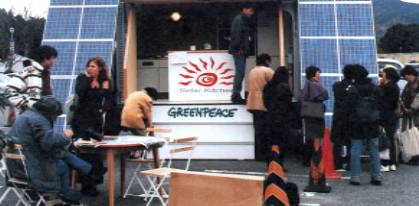Chapter III -3 :Quality of the Environment in Japan 1998
Chapter III: Transformation of Current Lifestyles
3. Lifestyle to realize "sound material cycle" and "coexistence of nature and human being"
Although there are many possible forms of lifestyle based on the concepts of sound material cycle and coexistence of nature and human being, this is one possible image based on the notion of the living and economic spheres discussed in Chapter 2.
In this hypothetical area, there are primary industries such as agriculture and forestry based on rice paddy field, forests. There are also food processing, forestry and construction industries, which utilize the product these primary industries produce and transport/distribution industry which carry them. Restaurants and retailers mainly sell fresh local products. These industries try to use, as much as possible, local resources, and strive to produce and sell value added products that are rare and unique to the area. Some products are imaginatively created and retain elements of local artistic traditions. Each product is produced in a way that causes as little environmental load as possible at the production, utilization and disposal stages. Moreover, the repairing and recycling industries and recycling shops are very common and people are accustomed to use the same goods for a long time.
Furthermore, facilities for environmental education and communal places where people can learn about local culture and history have been established and are managed by partnerships between local people and government.
People have more free time, by means of shortening the length of their commute by working nearer to home and of employing the work sharing system. At individual households and offices there are aquatic environments and people can work on family-run vegetable gardens during their free time. Buildings have energy saving structures and the utilization of natural energy and water recycling systems has been introduced.

Demonstrating a mobile kitchen using solar power
Industries and residences are placed so that they can coexist with wildlife habitats, and their size is within the environmental carrying capacity of watershed. In business and residential areas highly convenient public transportation systems are running and cycle lanes are laid out. In the town center a transit mall full of greenery is located where people can meet and chat. Natural areas such as rivers, green spaces, agricultural areas, mountain streams and forests are abundant. The maintenance of thickets and activities to help nature recover such as reforestation projects are undertaken on a voluntary basis by local inhabitants.
In these areas, people from all walks of lives and generations can meet, communicate and share each other's knowledge. With this kind of lifestyle, it is expected that one can obtain a rich life with natural blessings, reducing impacts on the environment.
As social systems are changed and human exchange is encouraged, a new lifestyle reducing environmental impact and promoting nature conservation and interacting with nature will be formed spontaneously. As a result, ecosystems will regain their richness and there will be more interaction between people and nature. Then rich and satisfying living will be realized, with health and safety secured.